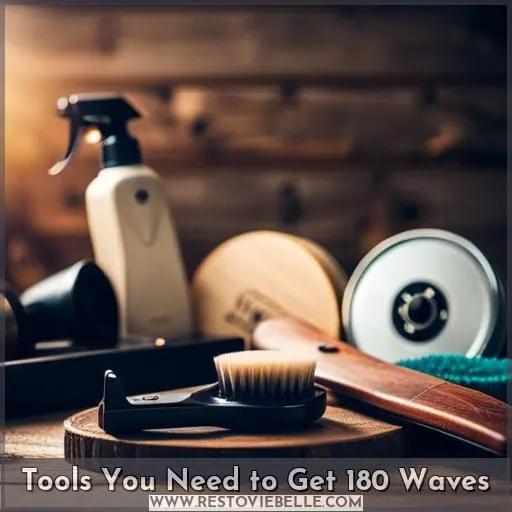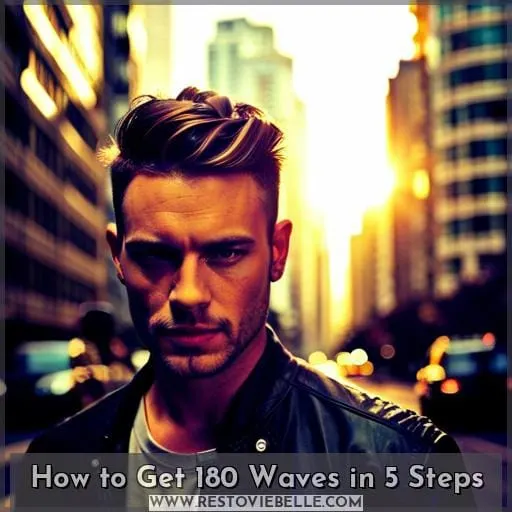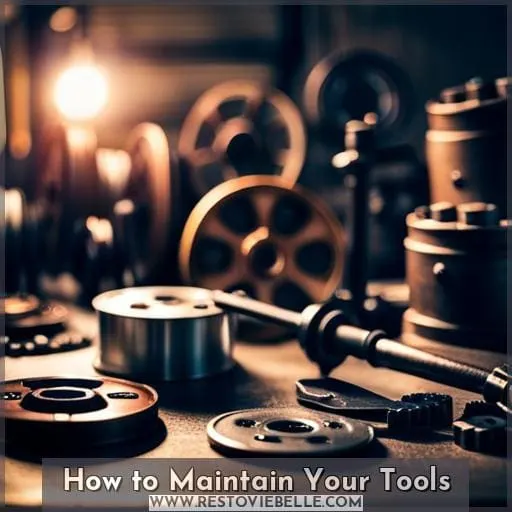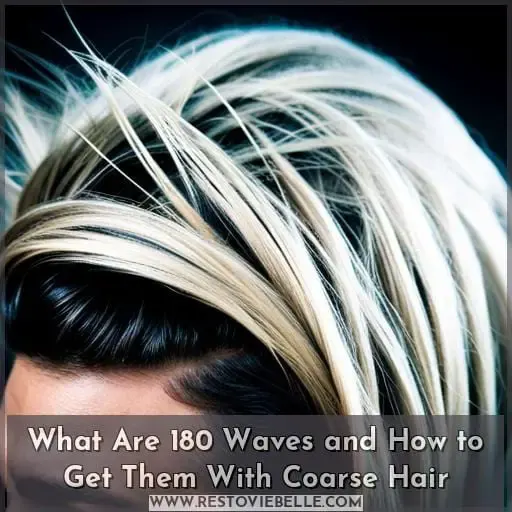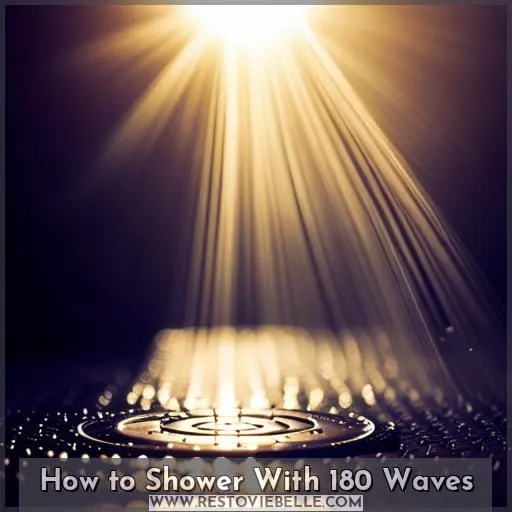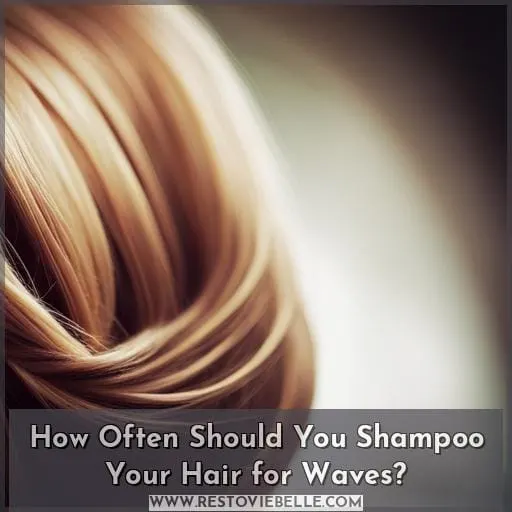This site is supported by our readers. We may earn a commission, at no cost to you, if you purchase through links.
 Are you ready to make a statement with your hair? Then 180 waves may be just the style for you.
Are you ready to make a statement with your hair? Then 180 waves may be just the style for you.
You’ll need some basic items like brushes, durags, conditioner/shampoo, and waving grease.
Table Of Contents
- Key Takeaways
- Tools You Need to Get 180 Waves
- How to Get 180 Waves in 5 Steps
- How to Maintain Your Tools
- What Are 180 Waves and How to Get Them With Coarse Hair
- Can You Get 180 Waves on Straight Hair?
- How to Get 180 Waves Without Using a Durag
- How to Shower With 180 Waves
- How Often Should You Shampoo Your Hair for Waves?
- How Long Will It Take to Get 180 Waves?
- Conclusion
Key Takeaways
- Use a stiff brush, durag, quality conditioner, shampoo, and waving grease for wave formation.
- Brush in circular motions and use different durag styles for various hair textures.
- Apply waving grease for defined waves, choosing the appropriate grease for your hair type.
- Tailor your routine and products based on your hair type and adjust the frequency of shampooing accordingly.
Tools You Need to Get 180 Waves
If you want to get 180 waves, then you’ll need the perfect combination of tools and products. A stiff brush, durag or wave cap, along with quality conditioner and shampoo, are essential for achieving this classic look.
Waving grease adds a finishing touch that helps create well-defined waves while keeping your hair looking healthy and shiny.
Brushes
Brushing your hair with the right wave brush is like sculpting a masterpiece, so choose one with boar bristles or nylon for effective results. Different brushes vary in material and technique; some require daily brushing while others need less frequent maintenance.
Brush frequency depends on hair texture—softer locks don’t require as much attention as coarser strands. Keep an eye out for loose hairs that may clog up the brush and reduce its effectiveness.
Durag
Slip on a durag and let it work its magic, protecting your wave pattern from frizz while you go about your day. Durags have many benefits, such as providing extra hold for hairstyles while also helping to maintain moisture levels.
Make sure to learn the correct tying techniques in order to get optimal results! There are various styles of durags available that will suit any head size or hair texture. They come in silky fabrics like silk or satin with adjustable straps and elastic bands for comfort.
To keep them in good condition, clean after each use by washing with warm water and laying flat until dry.
Conditioner and Shampoo
Shampoo and conditioner are the foundation of your 180 waves, nourishing them with moisture and adding shine – like a warm hug for your hair. When choosing products, look for ones that will hydrate while maintaining scalp health.
Hair washing techniques include shampooing weekly but conditioning daily; apply moisturizer to wet locks and brush in circular motions to form waves. Use a durag or wave cap over damp hair to maintain shape overnight; shower caps also help protect against water damage.
Waving Grease
To complete the look, apply a small amount of waving grease to your hair, following the direction of the waves. Waving grease alternatives, like pomade, can enhance wave depth and maintain moisture. Consider your hair type when selecting a product that works best for you. Consistency in hair care is key; regular haircuts and the use of a durag are important factors in achieving success with the 180 waves hairstyle.
How to Get 180 Waves in 5 Steps
Getting 180 waves is a great way to boost your confidence and create an attractive hairstyle. To achieve this look, it’s important to follow the right steps with proper tools and products. This includes washing your hair with shampoo and conditioner, applying waving grease for moisture control, brushing in circular motions using the correct brush type for your hair texture, and covering up with a durag or wave cap when not styling during the day or nighttime hours.
Wash Hair With Conditioner and Shampoo
Revive your waves with a gentle shampoo and conditioner that’ll nourish your hair and boost its health – don’t forget the durag! Co-washing, or using only conditioner to cleanse, is gaining popularity due to its benefits.
Shampoo should be used once every two weeks when co-washing. For those who prefer traditional washing techniques, opt for wave-friendly shampoos paired with a good leave-in conditioner. Conditioning techniques, such as raking, are essential after washing for maximum hydration.
Wave-friendly products can help you achieve beautiful 180 waves without compromising on moisture or texture.
Apply Waving Grease to the Hair
Once your hair is washed and conditioned, add waving grease to help seal in moisture and protect the waves. Choose a pomade that suits your specific needs, such as nourishment, shine, or hold. Learn wave pattern techniques from online guides or tutorials for the best results.
Avoid common mistakes like using too much product or over-brushing with hard bristles, as these can damage the scalp and cause breakage.
Don’t forget about nighttime hair care – use a durag to keep your waves intact while you sleep, ensuring a perfect hairstyle every morning!
Comb the Hair in Circular Motions
Gently brush your hair in circular motions with a stiff wave brush to enhance the 180 wave pattern. This technique helps shape and form the desired patterns while avoiding split ends and breakage, especially for coarse hair textures.
To achieve 360 waves, apply brushing patterns that encircle the entire head like a letter 8 or figure-eight formation. Use durags at night to maintain moisture levels and keep an even texture for deeper wave formations.
Cover Your Hair With a Durag
Secure your look by topping off with a durag, and experience the confidence of having perfect 180 waves that will last. Choose from materials like silk or satin for extra comfort, and use nighttime techniques like double-wrapping to maximize wave direction.
Try different styling variations too; experiment with taping seams shut for an even tighter fit.
Durags provide more coverage while caps are better suited if you’re looking to switch between styles quickly.
How to Maintain Your Tools
To achieve the perfect 180 waves hairstyle, you need to maintain your tools and take proper care of them. This includes regularly removing hair from the brush after combing, using the right amount of conditioner and shampoo, washing and drying brushes properly, as well as cleaning your hair cover or durag regularly.
Remove Hair From Brush After Combing
After combing, promptly remove any hair from your brush to ensure an efficient wave pattern. Keep up with regular haircuts for a crisp wave definition and use quality products like leave-in conditioner or pomade to combat dryness caused by frequent brushing.
Wear durags daily for optimal results and minimal friction when styling waves, while washing and conditioning should be done once a week with natural bristled brushes that evenly distribute oils.
Use the Right Amount of Conditioner and Shampoo
Use just enough conditioner and shampoo to keep your waves hydrated and bright, like the sun reflecting off a crystal-clear pond. Different hair textures require unique hair care adjustments for optimal wave maintenance.
Adjust moisturizing techniques based on the type of hair; coarse hair needs more moisture than finer strands. Wave-enhancing products such as pomades or oils can help achieve the desired look faster too! The optimal washing routine involves weekly shampooing with daily conditioning, plus covering up with a durag or wave cap at night helps maintain shape.
Wash and Dry Your Brushes Properly
Regularly cleaning and air-drying your wave brushes helps maintain their effectiveness for achieving those perfect 180 waves.
- Clean the brush after each use to prevent product build-up.
- Run the bristles through warm water with shampoo or mild soap.
- Rinse thoroughly and squeeze out any excess water from the bristles.
- Allow the brush to air dry in an open area, away from direct heat sources like radiators or hairdryers.
- Store it in a cool, dry place.
As part of an easy daily routine, including wearing a durag during the day and incorporating a shower routine at night, proper care for hair wave brushes will ensure their longevity when creating desired hairstyles.
Clean Your Hair Cover Regularly
To keep your 180 waves looking their best, make sure to clean your hair cover regularly. Durags and wave caps are essential for keeping the moisture in and maintaining the shape of a hairstyle. Washing durags or any other type of hair cover substitute should be done every few weeks to prevent mold growth and skin irritations.
To ensure optimal hygiene, use warm water with a mild detergent when cleaning these items, then hang them up to air-dry completely before using them again.
What Are 180 Waves and How to Get Them With Coarse Hair
Achieving 180 waves requires a tailored hair care routine, haircuts, and the right styling products to ensure your waves are defined and healthy.
To maintain wave progress, use the best brush types for specific textures. Avoid common mistakes like over-brushing or using too much product. Create defined edges with clippers for an attractive look. Achieve deep waves by adding waving grease to dampen the hair before brushing.
For straight hair, opt for stiff brushes made of boar bristles or nylon that will help lay down hairs in circular patterns better suited to coarse textures. When curls (3c/Tighter) are present, it’s essential to choose a bristle brush that won’t cause breakage while helping promote curl formation.
Thicker brushes tend to work better on coarser texture styles than thin ones do.
Additionally, it is important to maintain tools such as regular shampooing and cleaning durags/wave caps. Air drying them after every use is necessary to protect against any mold growth or bacterial infections from forming.
With time and patience, you’ll have those 180 Waves looking amazing!
Can You Get 180 Waves on Straight Hair?
Yes, you can achieve 180 waves on straight hair with the right products and routine! With a little patience and regular brushing techniques, you can create beautiful rippling hairstyles that will last.
Start by getting a haircut suitable for waves, such as level edges or a side taper, to help define your wave pattern. Then, use specific products like stiff brushes, durags/wave caps, conditioner, shampoo, and waving grease when creating your style.
Make sure the brush is tailored to your hair type. Hard brushes work best for coarse hair, while softer ones are better suited for shorter locks.
If using product, such as pomade, be sure to spread it along the direction of the waves to maximize effectiveness without damaging strands in other areas of the head due to excessive buildup or clumping.
Finally, remember that achieving great-looking 180s takes consistency. Keep up with weekly haircuts and washing routines, which should include wearing a durag throughout the day when possible.
How to Get 180 Waves Without Using a Durag
You can achieve 180 waves without having to use a durag by following a regular haircare routine and brushing with the right tools.
Alternative methods include washing hair 2-3 times weekly with shampoo, followed up nightly by applying water-based or buttery moisturizer on wet hair then slicking it forward. Use bristle brushes instead of wide-tooth combs to follow specific forward stroke patterns, aiming for around 100 strokes per section of the head.
For protection during showers, wear shower caps over durags. Haircut choice is also important – opt for taper fades suitable for your head shape as well as wave length size 1.
For nighttime routines, make sure you utilize natural products that are not too harsh on curls, such as shea moisture curly hair shampoo conditioner set, Cantu men cream pomade, Diane boar bristle brush men, or Satinior silky Durag Caps.
These products are designed specifically to achieve beachy vibes through style expert advice regarding men’s grooming and natural haircare tips.
Additionally, remember not only to keep cleaning/washing your brushes but also to regularly remove hairs from them in order to maintain combing efficiency while avoiding the risk of skin infection due to uncleanliness.
With these simple steps, you’ll be achieving hairstyle goals faster than ever before!
How to Shower With 180 Waves
Maintaining your 180 waves requires special attention, particularly during showering. To protect your waves from the water and properly wash them, you must understand how to care for them in a way that won’t damage their shape or curl pattern.
Protecting Your Waves From Water
Guarding your 180s from the elements is essential for long-lasting locks. When showering, use techniques that prevent frizz and keep moisture locked in.
Apply a light coating of pomade before getting in the water to help lock in moisture and hold the shape of your waves while you shampoo and condition. After finishing up, rinse with lukewarm water instead of hot. Hot water can strip away natural oils needed for healthy hair growth.
Additionally, try not to overuse shampoo as it will remove too much oil, which can lead to dryness or breakage over time if left unchecked! Once out of the shower, make sure you dry off properly.
Properly Washing Your Waves
To keep your waves looking their best, washing them properly is key. Start by using shampoo specifically designed for African American hair and apply it in sections. This helps to ensure even coverage across the scalp and prevents severe dryness or breakage from over-washing.
Use wave brushing techniques with a stiff brush during this process as well, such as using circular motions around the head to help form the wave pattern more evenly. Follow up with conditioner if needed before rinsing out all of the product completely.
This ensures that you don’t leave any residue behind on your scalp or strands that may cause buildup or damage over time.
Additionally, make sure to follow a regular moisturizing routine throughout each wash day for maximum hydration benefits.
How Often Should You Shampoo Your Hair for Waves?
For optimal results, shampoo your hair for waves twice a week – and in between washings, use conditioner to keep moisture levels high. Depending on the type of hair you have (coarse or fine), this frequency can be adjusted accordingly.
For example, if you have coarse hair, it’s recommended that you shampoo three times per week so as not to strip too much natural oil from the scalp and maintain a balance of moisture while still allowing wave progression.
If your locks are finer, then two shampoos should suffice each week depending upon how often styling products are used during brushing sessions with a stiff brush.
The techniques used when washing waves will also vary based on individual preferences. Some find it beneficial to simply massage their scalps prior to rinsing out product buildup, whereas others opt for gentle circular motions with fingertips across their forehead area where most of the 180 wave pattern originates from before lathering up throughout their entire head followed by thorough rinsing until all suds disappear.
Lastly, always remember that patience is key when attempting any new hairstyle – don’t expect immediate results but instead take comfort knowing gradual improvements will occur over time!
-
Frequency: Shampoo once every 2-3 days depending on specific needs & haircare routine
-
Hair Type: Coarser hairs may require more frequent washes than those who sport softer tresses
-
Moisture Balance: Use conditioners daily & adjust water temperature according to preference
-
Wave Progression: Regularly brush forward using appropriate tools/techniques combined with proper moisturizing agents
-
Shampoo Techniques: Massage scalp lightly prior to rinsing out product buildup + gentle circular motion along forehead area
How Long Will It Take to Get 180 Waves?
Achieving the 180 waves hairstyle can take up to two weeks with the right routine and tools. Different hair textures, wave pattern progression, patience, and consistency are all key components for success.
Adapting routines to suit your individual hair type is important in order to get the best results from your efforts.
To start, find a haircare routine that works for you. This includes using moisturizing shampoo, daily conditioning, and applying leave-in conditioner or pomade to maintain a healthy scalp and promote wave formation over time.
Using the proper grooming tools is also crucial. Depending on your hair texture, you may need a boar bristle brush or a nylon wave brush. Additionally, wearing durags or wave caps, especially overnight, can help in styling and maintaining the waves.
Patience and consistency are essential throughout the process. Wave pattern progression requires frequent brushing, with around 100 strokes per day. Washing your hair 2-3 times a week helps maintain moisture levels without damaging the scalp in the long run.
Regular haircuts every few months are also necessary to keep the length suitable for maintaining the shape of the 180 waves consistently over time.
It’s important to note that setbacks such as dandruff or unruly curls may occur during this process. However, with patience and commitment, it is possible to achieve beautiful and defined 360-degree curl patterns, regardless of your initial hair texture.
Conclusion
Finally, getting 180 waves is a great way to boost your confidence and customize your look. With the right tools, technique, and regular maintenance, you can achieve the perfect waves no matter your hair type and texture.
From finding the right brush and durag to washing and conditioning your hair correctly, the steps to achieving 180 waves are simple. Just remember to use natural products, brush in forward motions, and cover your hair with a durag for optimal results.

